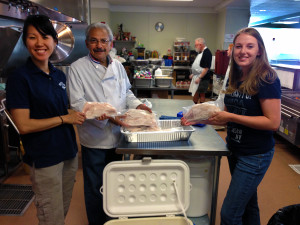Dead Tahoe fish sent to food pantry

St. Vincent’s food pantry benefits from the Tahoe fish kill. Photo/Catholic Charities of Northern Nevada.
With 51,000 pounds of fish harvested in a three-year pilot program to rid Lake Tahoe of invasive fish, scientists are finding a way to put the fish to good use.
This season about 55 pounds of fish fillets went to St. Vincent’s food pantry, which is operated by Catholic Charities of Northern Nevada.
The fish are mainly largemouth bass and bluegill, fish that usually live in warm water. Smaller-bodied fish, not suitable for filleting, are processed and distributed to Animal Ark Wildlife Shelter in Reno. Remaining fish byproduct is transported for composting with local compost processor Full Circle Soils & Compost in Minden.
Most of the fish that have been removed are from the Tahoe Keys in South Lake Tahoe. Crystal Bay and Cave Rock have been other locations where scientists have worked.
The research is conducted in collaboration with UNR and the California Department of Fish and Wildlife.
After fish are temporarily stunned, researchers scoop out the nonnative fish using nets at the end of long poles, while the native fish return to their natural state in a few minutes and swim away.